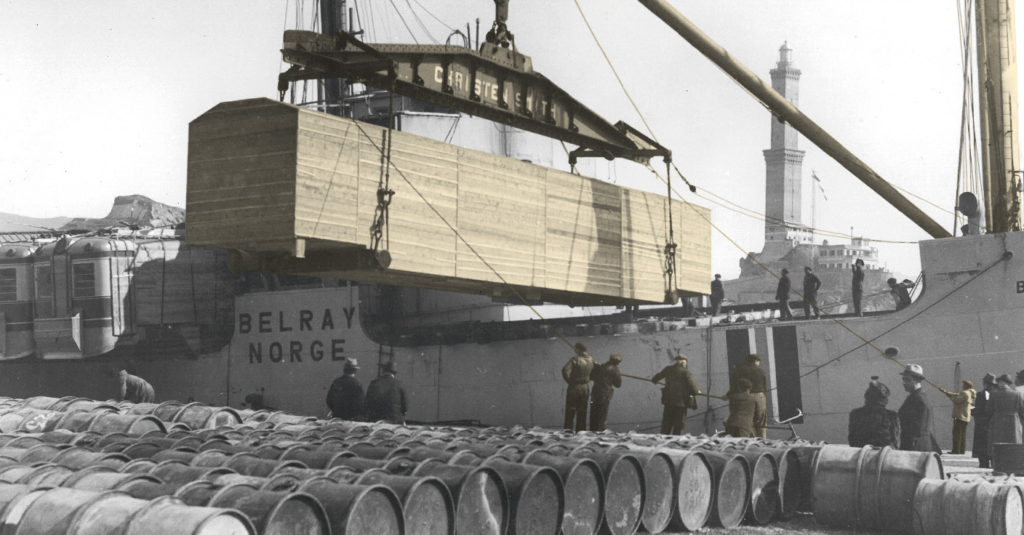Il porto si spinge a ponente
e diventa “moderno”

Prima dell’avvento dei container, ai piedi della Lanterna si scaricavano casse, sacchi, barili e… vagoni. Questo è Ponte Etiopia nel 1940, durante l’imbarco di littorine (le automotrici/vagoni a motore d’epoca fascista.). La gru, in questo caso, non è sul molo, ma è un mezzo di bordo // Before the advent of containers, the foot of the Lanterna was used to unload crates, sacks, barrels and… wagons. This is Ponte Etiopia in 1940, during the unloading of rail-cruisers (self-propelled wagons of the Fascist era). The crane, in this case, is not on the pier, but is actually on deck
Dove una volta era il mare, trovano spazio moli, container e… aeroplani!
Le distruzioni della Seconda Guerra Mondiale resero necessaria la quasi totale ricostruzione del porto. Grazie a uno notevole sforzo collettivo si riuscirono a concludere i lavori già nel 1948. Ci si spinse verso ponente e verso il mare creando nuovi moli per rispondere alla necessità delle imprese navali di gestire in maniera esclusivistica le banchine. L’accresciuta importanza di carbone e petrolio fece sì che a Cornigliano e a Multedo si organizzassero terminal riservati. Negli anni Sessanta, l’avvento epocale dei container portò alla creazione a Sampierdarena del primo terminal nel Mediterraneo dedicato a questo nuovo sistema di trasporto merci. I moli e le gru che vedete sono quelli delle calate dell’ex-idroscalo (qua atterravano e partivano gli idrovolanti – negli anni Venti e Trenta c’erano voli di linea quotidiani con le maggiori città d’Italia, con Tunisi e Southampton), di Ponte Etiopia, Calata Inglese e Massaua e sono gestite dalla fine degli anni Novanta dal Gruppo Spinelli. Sempre a Ponente, oltre la foce del torrente Polcevera, si riconoscono le piste e le strutture dell’aeroporto di Genova Sestri: inaugurato nel 1962 e dedicato a Cristoforo Colombo, è stato letteralmente costruito in mare su una penisola artificiale.
The port moves to the west and becomes “modern”
Where the sea once was, now docks, containers and… airplanes!
The destruction caused by World War II required the port to be almost completely rebuilt. Thanks to a remarkable collective effort, works were completed in 1948. New docks were built to the west and out into the sea to accommodate the shipping companies’ need for the exclusive use of the berths. The growing importance of coal and oil led to the creation of reserved terminals in Cornigliano and Multedo. In the 1960s, the historic advent of containers led to the building in Sampierdarena of the first terminal in the Mediterranean dedicated to this new system of freight transport. The piers and cranes you see are on Ponte Etiopia, Calata Inglese and Massaua, which make up what once was a former seaplane base (in the 1920s and 1930s there were daily scheduled seaplane flights to major Italian cities, plus Tunis and Southampton); this area has been managed by the Spinelli Group since the late 90s. Still to the west, beyond the outlet of the Polcevera river, you can see the runways and facilities of the airport of Genoa Sestri: inaugurated in 1962 and dedicated to Christopher Columbus, it was literally built on an artificial peninsula on the sea.
